Here’s a beautifully renovated, ex-JCB ERF EC11
Posted by Chris Graham on 1st August 2024
Bob Birchenough’s ERF EC11 was good when bought, but six months on it’s even better. Peter Simpson tells the story.
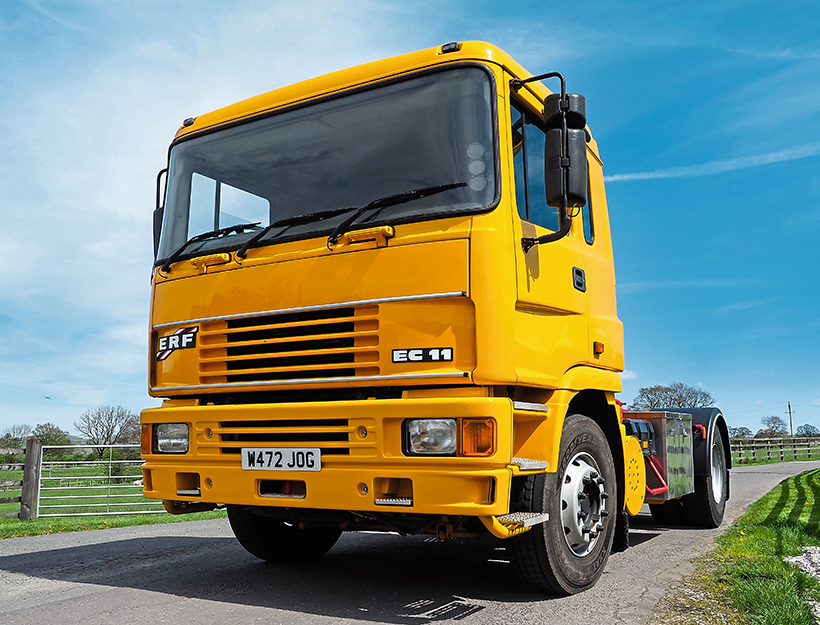
Bob Birchenough’s superb ERF EC11.
JCB’s famous fleet of refurbished ERFs will probably need little introduction to most enthusiasts, but to recap briefly, the privately-owned British manufacturing business had bought new ERFs from 1965 until 2002 when, following ERF’s incorporation into MAN, it was felt that the new generation of trucks then on offer would not be as suitable for its needs.
So rather than buy new, between 2003 and 2006 the firm decided to buy up used six-to-12-year-old British-built ERFs and refurbish them in-house to as-new condition. Though, as one of Britain’s biggest and best-known manufacturing businesses, JCB was keen to be seen as supporting British manufacturing, the decision was made for purely commercial reasons. It was not driven by sentiment and never intended to be a permanent feature of JCB’s operations.

Side view shows to good effect how adding the spare wheel carrier made the ERF look more balanced despite losing its tag-axle.
The EC fleet did, however, remain in frontline service until 2021 bearing testimony to that being the right call; new lorries bought in 2006 would have had to be replaced at least once by 2021. The first disposals were in 2018, when it was announced that the EC11 operation would be ending in 2020. Covid, however, gave the fleet a one-year reprieve.
Unsurprisingly, a lot of the ex-JCB EC11s went abroad; we understand that some were even cut in half prior to loading, so they could be imported to their new homes as spare parts rather than complete lorries.
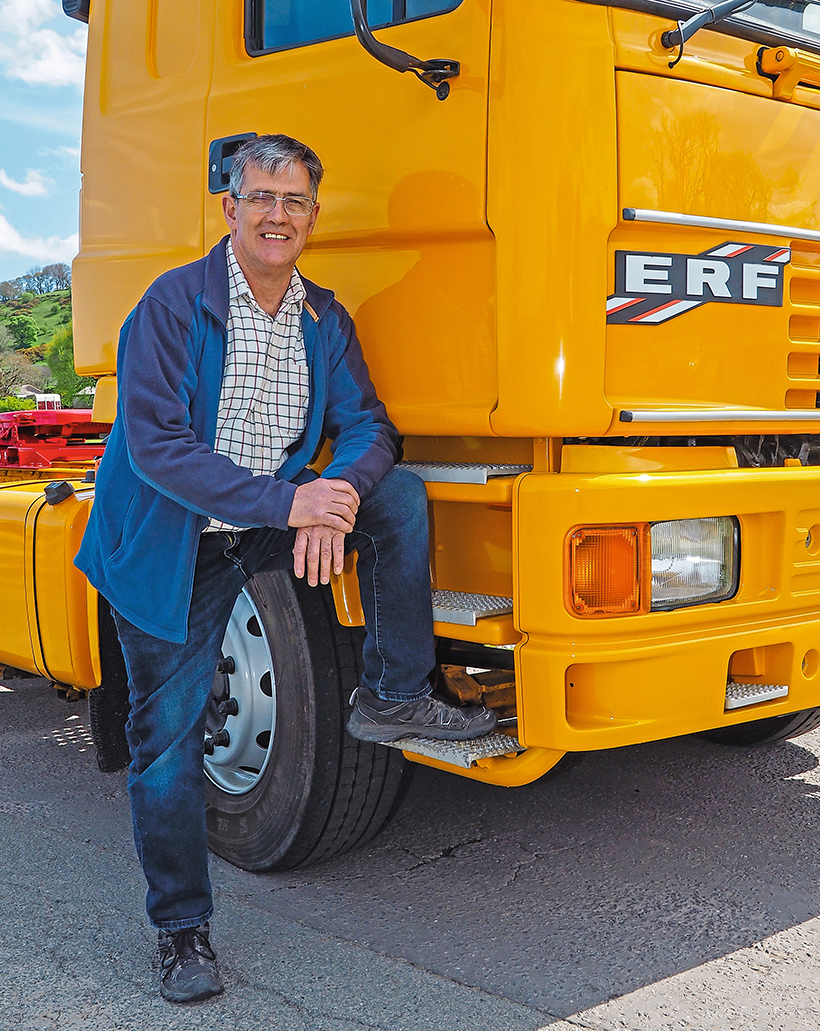
ERF EC11 with deservedly-proud owner, Bob Birchenough.
Thankfully, however, a number have passed into private preservation in the UK and one of these is W472 JOG, now owned by Staffordshire-based enthusiast Bob Birchenough. Bob has featured in these pages before; back in 2015 we covered his first lorry renovation project; a Foden S83. Recently, his partner June had been showing interest in driving Bob’s Foden, but he is the first to admit that it’s “not an easy lorry to master, certainly not for the first attempt.”
Renovation and improvement
EC11 380 W472 JOG was new on June 7 2000, and was bought by JCB in from Aquila Truck Rental of Crewe – a firm from whom JCB bought a number of its EC11s which came in with W+++JOG registrations, though many of JCB’s EC11s were run on personal ‘JCB’ registrations. Bob believes that his lorry was used by a West-of-England dairy during its time with Acquila.
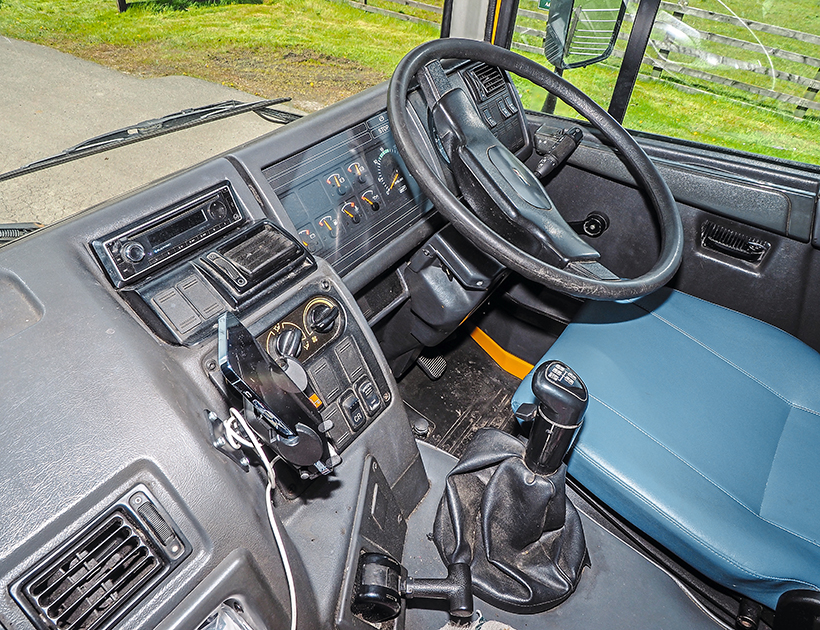
Classic late-1990s lorry dashboard and instrumentation.
As bought by JCB W472 JOG was a three-axle 38-ton tractor unit. It was put through the full in-house refurbishment programme and at the same time converted into a two-axle 28-tonner; the official date of downplating was 09/10/06.
The JCB EC11s were used to transport moving components and part-completed vehicles between the plants in and around Staffordshire, and for taking demonstration machines to and from potential clients. They were also extremely well-maintained in house. As well as the usual six-weekly mechanical inspections they were cleaned weekly by drivers, who were also ‘encouraged strongly’ to keep their cabs clean and tidy, with time for this allowed in work schedules. With the lorry, Bob received a complete service and maintenance history from its 15 years with JCB; unsurprisingly, it runs to several folders.
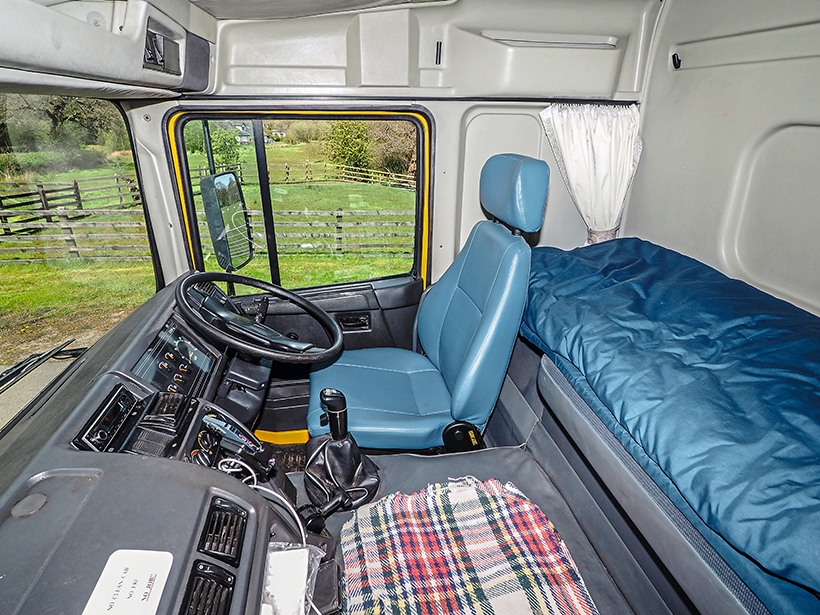
Sleeper cab, although JCB has always had a ‘no sleeping in cabs’ rule, due to founder Joseph Cyril Bamford believing that a good day’s work depended on a good night’s sleep.
W472 JOG remained active with JCB until the end of operations in 2021. Indeed, we saw it in the workshop having a final pre-sale check and service (all the lorries being sold were given a final full in-house service prior to sale) when we visited the firm’s transport operation in August 2021 to report on preparations for the sale. It was lot number 208 in the auction on September 28 and sold for £10,500 (the 4×2 EC11s typically sold for £10-11k apiece).
The buyer was Mark Wintle, based in Dursley, Gloucestershire who, according to Bob, intended to “tidy it up a bit and keep it for private and personal use as a hobby and keep the lorry in preservation.” Mark did take it on a few road-runs, and rebuilt the gearbox and fitted a new clutch during his ownership, but the lorry needed nothing else in the two years and two MoT tests that he owned it. Unfortunately, however, family and other commitments meant he didn’t have time to use and enjoy the ERF as much as he intended, and in August 2023 it was advertised for sale in Classic & Vintage Commercials. Bob bought it from Mark on September 14 2023 after an inspection and test drive with son Alan.
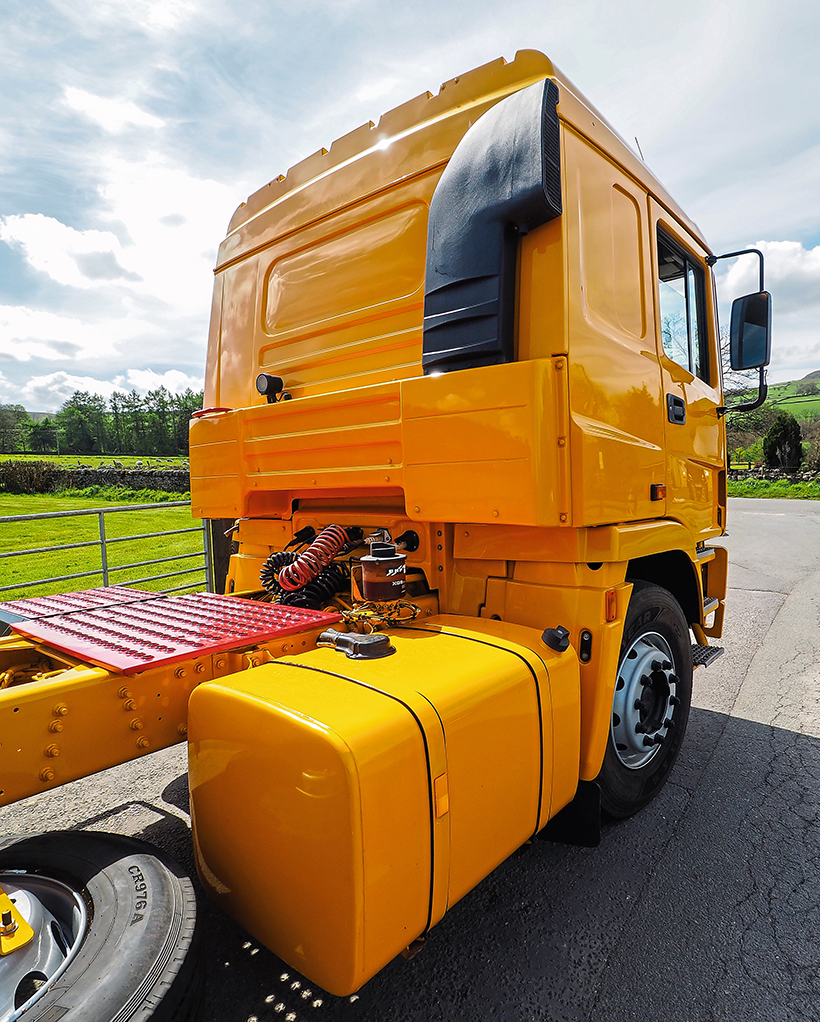
Rear of cab; all very nice and tidy!
Bob chose this lorry for two reasons. The first, as previously noted, was so that his partner June could drive it. He was also after a lorry which could be brought up to superb preserved condition quickly, and an ex-JCB EC11 seemed a perfect base from which to create that.
And that is what Bob has managed to achieve. What’s more, the lorry has been done in the space of just seven months, a great testimony to both his own skill and tenacity, but also the quality of the vehicle he started with.
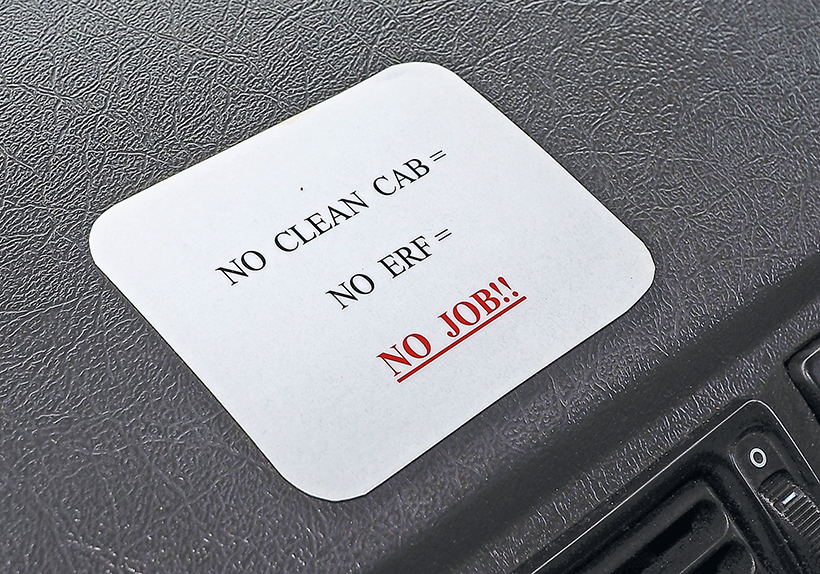
All JCB lorries had a note like this in the cab as a ‘reminder’ of the standards expected.
The main area requiring attention was the cab. There was some corrosion in the floor and door shuts, which almost certainly resulted from a roof water leak which turned out to be caused by nothing more than a failed aerial seal. That was an easy fix, but the collateral damage it had caused took rather more sorting, and had probably been made worse by the lorry’s lack of use over the previous two years. Bob also felt that the cab paintwork was generally a bit patchy, with most external panels having been painted separately, and this was now starting to show. There was also a bit of light but unsightly body damage to the cab and bumper’s nearside, and a little damage at the back where the cab appeared to have been lifted using a rail to gain access to the engine. The interior also needed a bit of refurbishment due principally to the water ingress, and the panel behind the driver’s seat needed recovering.
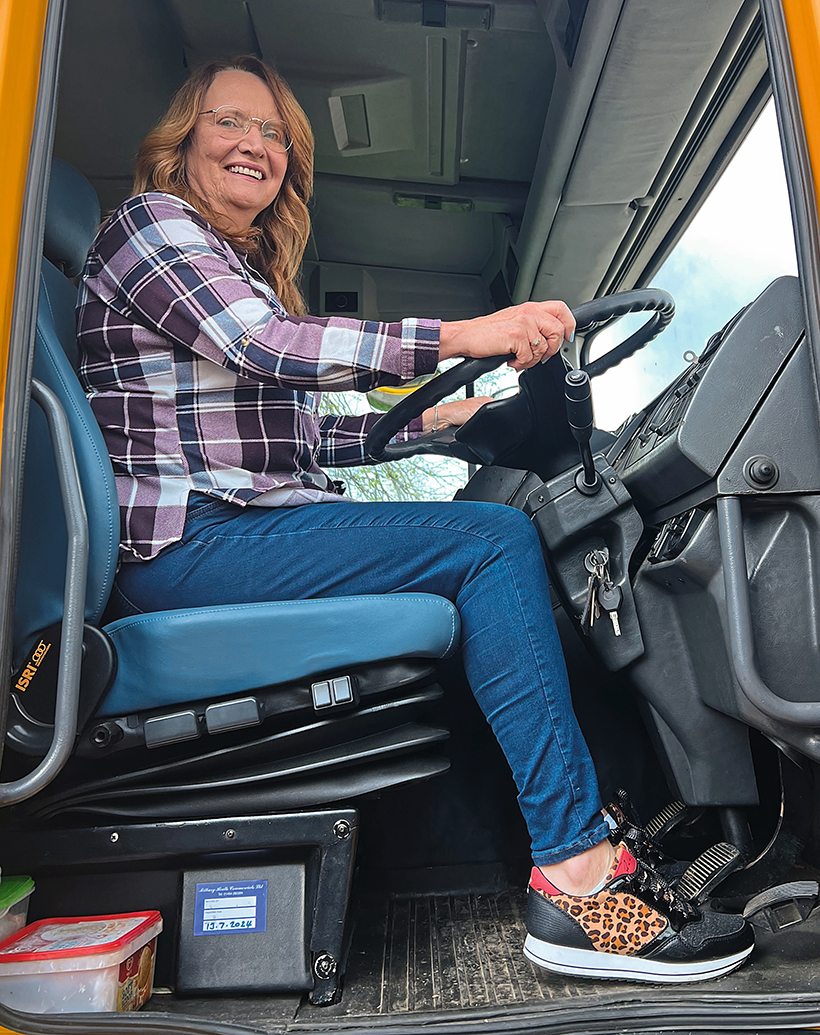
June taking a turn at the wheel.
Chassis-wise, there was a fair amount of inner surface corrosion, principally around the crossmembers, all of which needed careful and painstaking removal and repainting. The rear wings and saddle brackets also needed renewing. The mechanical side of things was generally very good, though new rear airbags and shock absorbers were needed, along with a replacement offside brake backplate. Finally, the air tank brackets all needed renewing
All the lorries being sold were given a final full in-house service prior to sale Bob sourced all the parts needed to do this work, and carried out most of the cab preparation work himself. He has also made a few changes for cosmetic reasons and to suit June’s and his needs better. Specifically, he felt that the ‘gap’ in the chassis where the second rear axle had been made the lorry look a bit odd (the chassis was still at its original length) so to fill this he fitted a spare wheel and carrier on the offside and a storage box on the nearside. Such things were not needed at JCB, as their lorries were almost always operated on a ‘home at night’ basis. Finally, as the intention is that June and Bob will take turns and driving the EC11, an air-sprung passenger seat was needed.
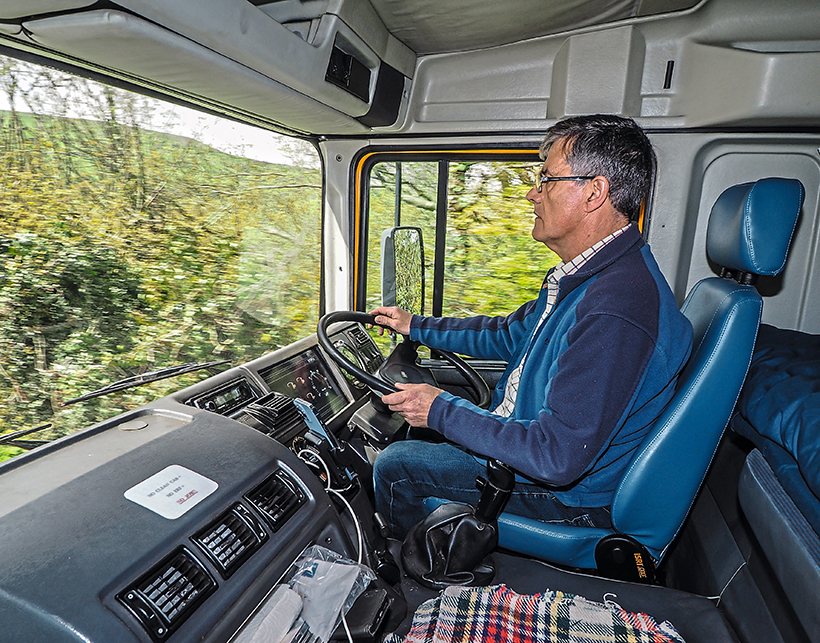
Bob at the wheel – and in a ‘clean cab’…
On February 16 2024, the truck was taken to Lee Moorscroft’s premises for finishing-off and painting. Six weeks later, on April 11, it came back. Its first appearance, on the Shap and Lakes Road Run, was scheduled for April 14. A frantic three days therefore ensued to ensure the EC11 was ready. It was, and completed the run without incident. Since then, it’s been to Llandudno and further appearances are planned; the emphasis here is, we were told, on driving rather than parking up in fields.
Conclusions
There’s little doubt at all that this has been a fabulous job, and talking to Bob, one is left in no doubt whatsoever that he is extremely enthusiastic both about lorries in general and the EC11 in particular. The question, though, which I’m sure some of you are asking is why did this lorry, from a cherished and cared-for fleet like JCB, need this amount of work less than three years after being sold?
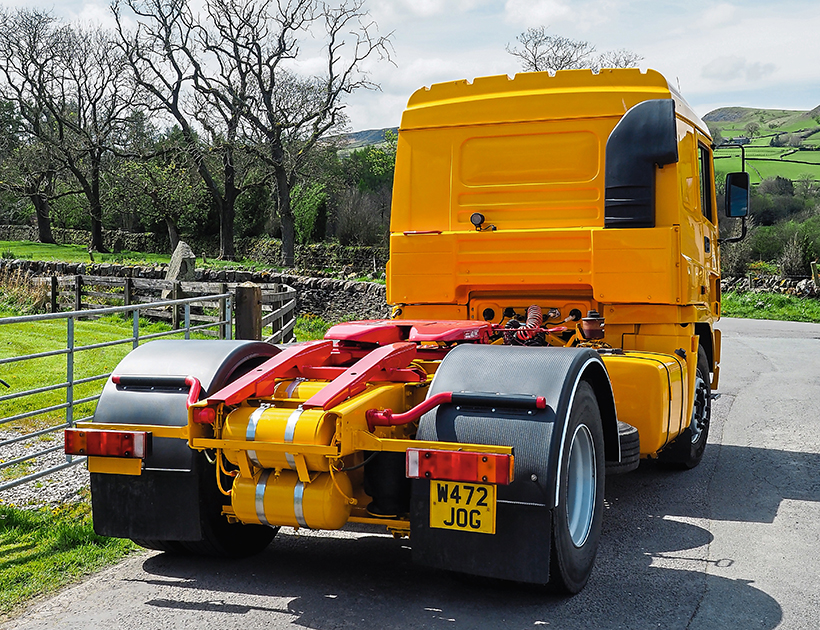
I think there are two answers to this, neither of which cast any doubt whatsoever on the standard of JCB’s renovation and subsequent care. The first is that most of the cab rust and internal damage was down to that aerial leak allowing rainwater to get inside. The second thing, though, is down to the difference between working lorries and tip-top preservation. The best working lorries get used, and irrespective of how much care they get, working lorries age with use. There are also plenty of things – such as surface chassis corrosion which no-one with a working lorry would really worry about. Apart from anything else, in normal use the life of an unblemished finish is measured in months rather than years. However, for a top-end renovation on a lorry that’s no longer working commercially, perfection is very possible and what many owners seek to achieve. And doing that when you’re starting out with a very good working lorry is a whole lot more straightforward than taking a ground-up restoration to this standard.
In conclusion, Bob would like to thank the following people for their assistance and support: Alan Birchenough for help, advice and support, Harry Wilkinson and Dave Dranfield for “Good Work”, Hayden Walker for the spare wheel carrier, Andy at Marsh Green Trimmers (ex ERF) for the seats. Paul Parker and Taylor Bland for trim parts, Martin at Cheshire Truck Parts for parts, High Peak Sheet Metal for making the tank straps and storage box, and Lee Moorcroft for body and paint work.
This feature comes from the latest issue of Classic & Vintage Commercials, and you can get a money-saving subscription to this magazine simply by clicking HERE
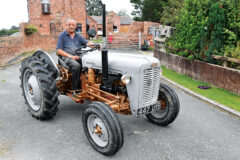
Previous Post
Superbly restored 1957 Ferguson 35
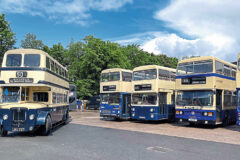
Next Post
75th anniversary of Birmingham’s Number 50 bus route



